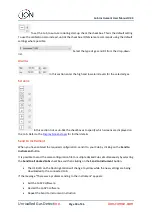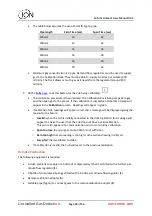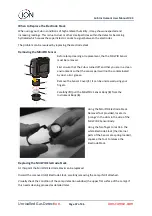
Cub Instrument User Manual V2.4
Unrivalled Gas Detect
ion.
Page 40 of 46
ionscience.com
Carefully remove the Lamp:
•
If the Lamp is held in the Electrode Stack, carefully pull it out of the O ring around the well in
the underside of the Electrode Stack.
•
If the Lamp is sitting in the Sensor Body - the Lamp can be gripped and lifted out or the
Sensor Body can be inverted and the Lamp tipped out.
Discard the removed (old) Lamp.
Place the Electrode Stack onto a clean, flat surface, flat surface downwards. Carefully twist the
detection window end of a new Lamp into the O ring around the well in the underside of the
Electrode Stack. The Lamp window should now sit flush within the Electrode Stack.
This procedure ensures that the Lamp is firmly held in the Electrode Stack with
the detection window, level with the electrodes for consistent and reliable VOC
readings. Lamp placement by any other means is likely to give unreliable readings
because the O ring in the Electrode Stack becomes trapped between the window
face and the Electrode Stack.
Carefully align the Sensor Body over the Electrode Stack plus Lamp. Push the Sensor Body down to
secure the assembly - two clicks should be heard.
Carefully align/push the new MiniPID 2 Sensor Body (
4
) into the Instrument Body (
6
).
Then ensuring, the Filter Disc (
2
) and O Ring (
3
) are correctly positioned, screw the Sensor Cover (
1
)
back onto the Instrument Body (
6
). Do not over-tighten.
The instrument MUST now be re-calibrated.
Bump Testing
Bump tests should regularly be carried out on your Cub to test that the instrument responds
correctly and that the alarm indicators are triggered correctly when gas is detected at the
levels specified in the Cub’s configuration
. Bump tests should also be carried out when these
specified alarm levels are changed.
The
Bump Test
checkboxes (in the
Bump Test
) is used to specify
the gas to be used during the bump test; the options are PID Gas and Calibration Gas.
The bump test procedure follows a similar procedure to that for calibration ( see
, except that the procedure is initiated by pressing the following button
on the







































